This month marks the 30th anniversary of the first issue of IslandSide, the venerable magazine founded by Jim Brown in 1989.
Here’s the Editor’s Note from that issue:
This is the first issue of IslandSide Magazine and I hope that, no matter where your interests lie; in politics, sports, the arts, history, fashion; you’ll find something here worth reading.
This month’s cover story is an interview I had with Joe Ghiz in December. I wanted to interview the premier to get his response to the post-election conventional wisdom that’s been swirling around the Island that, a) he is largely responsible for the Liberal sweep of seats, and b) he is gearing up for a provincial election so that, with another victory under his belt, he can turn his sights on Ottawa.
Not unexpectedly, the premier wasn’t giving anything away during our talk, but I think you’ll find his answers interesting and, although Mr. Ghiz didn’t come out and say so, I’d say a spring provincial election looks like a pretty good bet. I say that for two reasons, his vagueness when asked about calling a by-election to replace Prowse Chappell, and his apparent decision to retain the agriculture portfolio.
Barbara MacAndrew‘s story on land speculation was written before Community and Cultural Affairs Minister Gilbert Clements announced his freeze on land development pending the findings of the Royal Commission on Land Use. While his announcement addresses, at least temporarily, some of the concerns raised by Ms MacAndrew, her story provides a detailed illustration of the facts that led to the minister’s unprecedented move.
This first issue introduces readers to IslandSide’s three regular columnists. Two of them, Deirdre Kessler and Jack McAndrew, are well known to most Islanders. The third, Campbell Morrison, will be writing every month on the actions of our Island MP‘s and senators from his vantage point in the press gallery on Parliament Hill. Mr Morrison operates a news service for Maritime daily and weekly newspapers called NewsEast.
One regular feature of IslandSide that doesn’t appear in this issue. because it is the first, is the letters to the editor section. We welcome all letters and look forward to some lively debate.
I’d like to close this first Editor’s note by thanking all of the writers, photographers, artists and advertisers who took a chance, sight unseen, on IslandSide Magazine. I’d. also like to thank Jim MacNeill of the Eastern Graphic for his guidance and assistance.
IslandSide ceased publication about 6 months before I landed on Prince Edward Island and thus has long served as a helpful introduction to the cast of characters that have populated my quarter century here (I will never forget the time that—by that time Lieutenant Governor—Hon. Gilbert Clements called me looking for technical support for his Internet connection; what strange planet had I landed on).
The highlight of Issue 1 for me was Jack MacAndrew’s back page column on George Proud’s defeat of Tom McMillan, Bouquets for Ordinary George, which ended like this:
Ordinary George won one for the ordinary people. The little man you’d never notice in a crowd, stepped out of the pack and let his ordinariness win it for him. He was simply himself, without pretence, and that turned his ordinariness from a putdown to a positive. That’s the fact of the matter, whatever they may think in the drawing rooms of Brighton.
Something else. Ordinary George will do just tine at those cocktail parties on embassy row. Decency, straightforwardness, and personal humility are attractive attributes in any language. I can hear him now, telling the regulars at Tim Horton’s all about those splendid affairs.
How I wish we had someone with Jack’s insight and skill with words to interpret the times we’re living through now.
Jim Brown, of course, went on to become a national broadcasting treasure, most recently at The 180; a tip of the hat to him on this anniversary.
Thanks to my friend G. for leaving a copy of Volume 1, Number 1 on my doorstep this afternoon.

As an experiment I decided to see if I could print a fountain pen on my 3D printer
I found this Open 3D Fountain pen model on Thingiverse, and I’ve been printing it this week (each of the three sections take a couple of hours or more to print).
One of the things I realized when I went to print is that when I switched from using a MacBook Air to using a Mac Mini as my computer I lost the use of an SD card reader. I could have powered up the MacBook Air, but I opted instead to use the opportunity to experiment with OctoPrint, the self-styled “snappy web interface for your 3D printer.”
OctoPrint makes the process of using my Monoprice Select Mini 3D printer so much easier: rather than having to schlep an SD card around from computer to printer, I just connect the printer to the Raspberry Pi I set up (via OctoPi) with OctoPrint and then can control and monitor the entire print process from there.
OctoPrint has some very nice features.
The Temperature tab shows me the temperature of the print head and of the heated bed (and let’s me adjust, if needed):

The GCode Viewer tab shows me the print head in real time:

And the Control tab shows me a live view of the print job via a webcam that I’ve connected to the Raspberry Pi:

OctoPrint can create a timelapse of the print job, using parameters I set; here’s what it created when I set it to take a timelapse shot every 10 seconds and printed the pen’s barrel:
And here’s a timelapse of the printing of the cap, taken from a different angle:
I’ve printed the three parts of the pen and, despite that I have a low-end printer, to my surprise, aided by a little bit of beeswax, the threaded parts screwed together without issue.

Here’s the barrel screwed to the top:

It doesn’t look like a million bucks, but with some sanding and perhaps some painting, it might amount to something more than a striated hulk.
I’ve ordered a JoWo #6 nib to complete the pen, and once it arrives I’ll assemble everything and see how it feels as a pen.
In a December blog posts where he discussed the 2019 quarter-millennial of St. Paul’s Anglican Church, Archdeacon John Clarke wrote about the parish’s tagline for the year, A Caring Community for All:
With it we haven’t given up anything and other ways that we might describe ourselves are not lost. This tag-line will serve us for the year to remind ourselves and tell the world what we are trying to be.
But here’s fair warning, “All” mean all. Make no mistake about it—everyone, no matter their circumstances or history will fine a caring community at St. Paul’s. People ridiculed, ignored, beaten, or lost in this world are welcomed here and will be cared for to the best of our abilities. Or we change “all” to “some” and that just doesn’t seem true to the Gospel.
While I rarely take the religious route into Archdeacon Clarke’s words, I almost always connect with them on other levels, and for this sentiment that is particularly true. I am proud to be a secular affiliate of an institution that shines light so universally.
In Building Ethical Organisations, Cerys Hearsey writes, in part:
Here are some of the most important steps that leaders and employees can take to ensure that grass-roots ethics and organisation-wide actions meet in the middle:
- Create psychological safety: if employees are safe to speak out, they will feel safe to stand by their principles. This is essential for creating an environment where questions can be asked about long term impact without the fear of long term consequences for careers.
- Explore long-term impacts in a dedicated sprint: building in an ethics sprint (or at least an ethical element to user stories) can help teams new to the concept of voice these concerns focus on long-term, unforeseen impacts.
- Gather signals from customers in real time: in the event of a breakdown inside the organisation, customers also act as an early-warning sensor network to issues and potential resolutions.
- Multi-disciplinary, diverse agile teams: different mental models and ways of working help combat groupthink and echo chambers around developing products and services.
- Transparent by default: challenging the need for closed communications, collaboration and co-operation communities is an excellent step towards ambient awareness across silos.
While not specifically written about government, these steps also seem like excellent ones to apply to public service culture.
I’ve been on the list of witnesses to speak to the Public Accounts Committee about open data for almost a year; when the committee finally meets to consider this issue, the core of my testimony will involve the suggestion that open data is not primarily a technical issue, but rather one of culture.
What Hearsey calls “psychological safety” is something largely missing from the public service, where the information one manages and controls is too often treated as trade secret; I’d like to see us move toward a culture where public servants are rewarded not for keeping the data safely hidden in the vaults, but rather for telling any and all, as often as possible, what they do, how they do it, the metrics they use to measure success and failure, and the data that describes their work product.
Sometime last year I resolved that if I was going to link to a business, institution, or anything else with a geographic location from one of my blog posts, I’d link to OpenStreetMap, and I’d use the opportunity either to create missing entities on the map, or to update those already there.
This approach has several benefits: it means I’m linking to real, useful information, as opposed to a business’ marketing websitem and it builds OpenStreetMap updating into a regular, natural habit.
Take this blog post about salted capers, for example, where I mentioned Riverview Country Market.
On my Mac I have an Alfred search set up that allows me to quickly get the URL on OpenStreetMap for something, just by pressing Control+Space and then typing map and then the name of the something, like this:

This search showed me that there was already an entity for Riverview Country Market on OpenStreetMap:
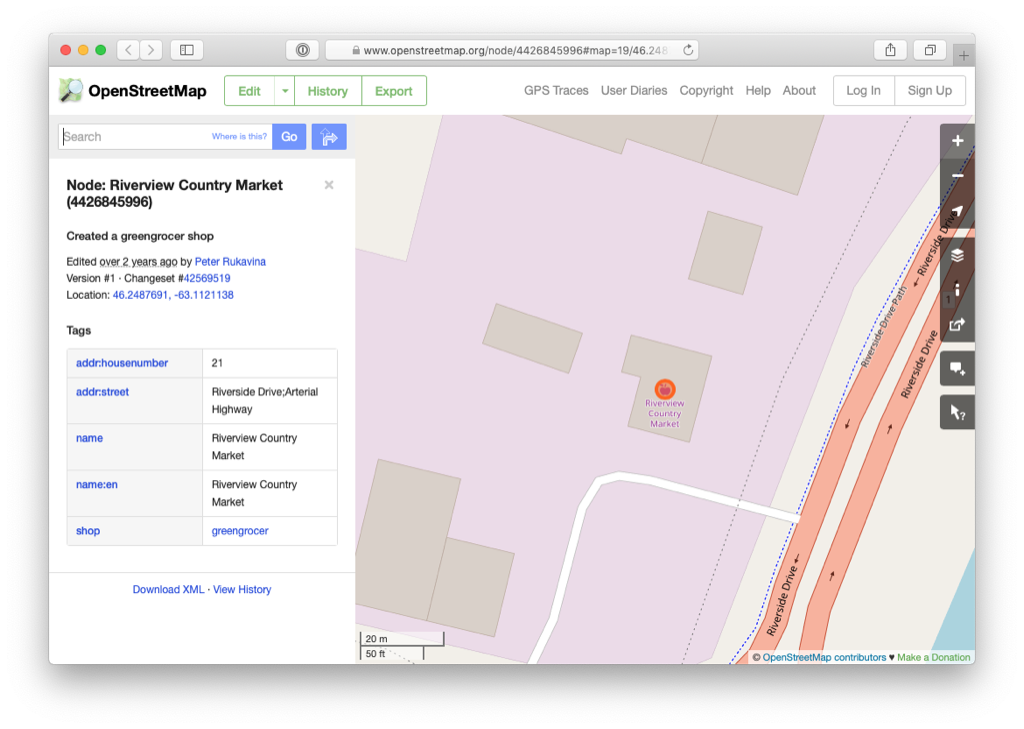
While Riverview was on the map (put there, as it turns out, by me, 2 years ago), the metadata about Riverview was incomplete, so I set out to enhance it by clicking Edit and logging in to OpenStreetMap (this is free, and anyone can do it).
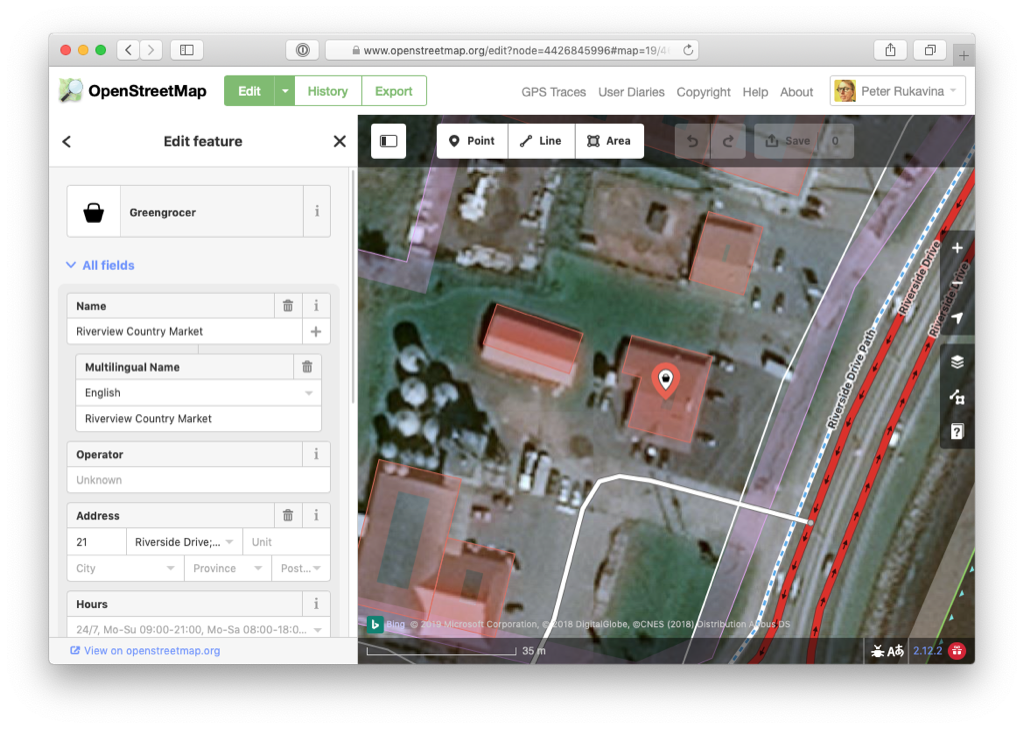
Using the panel on the left, I did the following:
- I corrected the address, from “Riverside Drive;Arterial Highway” to just Riverside Drive.
- I added the missing city, province and postal code.
- I added Riverview’s opening hours, website, email address and a brief description.
- I moved the point for Riverview down slightly to allow me to also add a point for KJL Select Meats, which occupies the same building, and I added details for KJL as well.
- I added the parking lot and driveway.
Once I saved my edits, and waited a few minutes for the map tiles to get re-rendered, here’s the result of my changes:
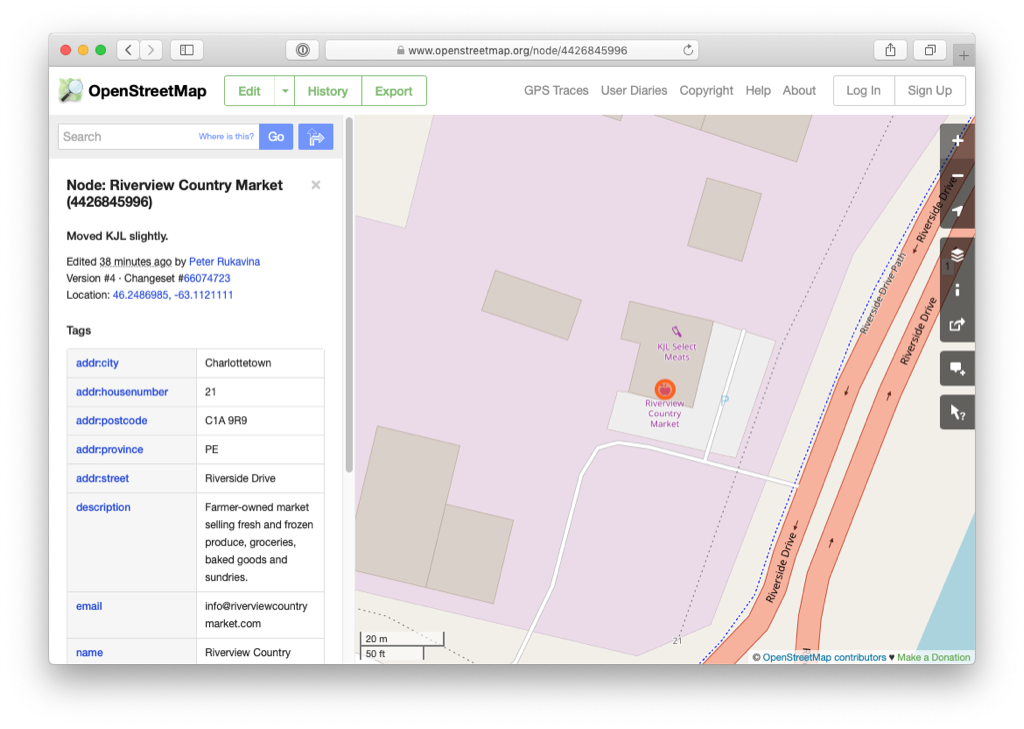
Now, granted, the rendering of the metadata for Riverview is more utilitarian than beautiful, but remember that I’ve just updated the the OpenStreetMap data from which all derivative products that use its data are drawn, from mobile apps to hiking maps to sites that show opening hours. So, for example, this website that draws an “open hours layer” on top of OpenStreetMap has already been updated:
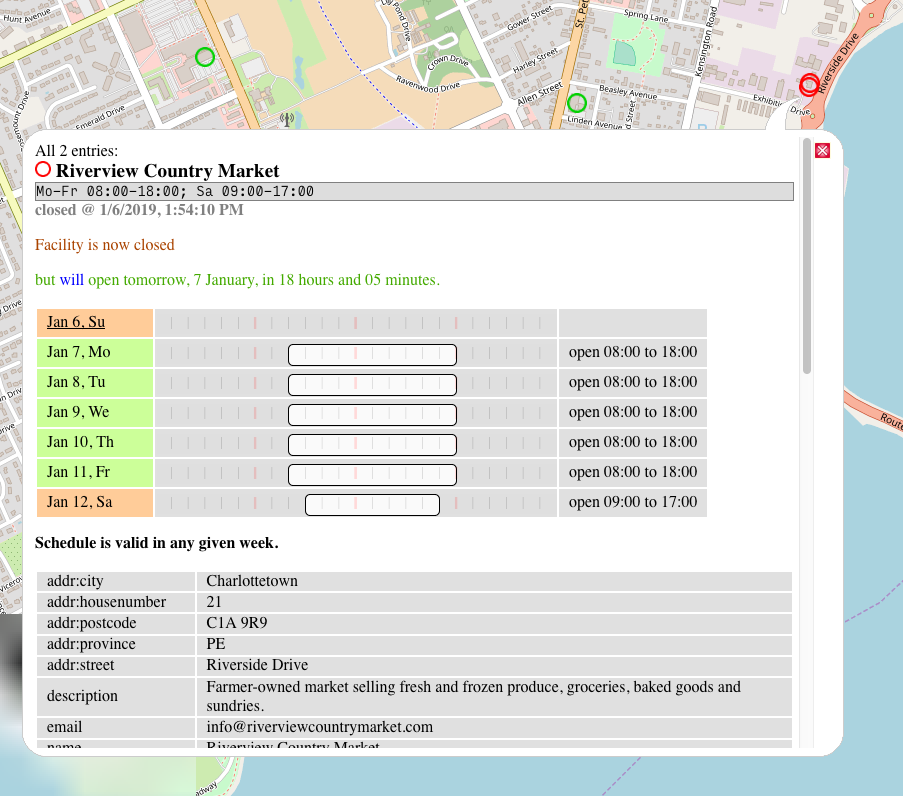
Will you join me in this blogging habit?
We picked up a bottle of Delicias Salted Capers yesterday during our weekly shop at Riverview Country Market: it was the sheer absurdity of the product that drew me to it, given that regular capers already seem to be maximally salted.

I used the salted capers later the same day: I cooked up some rotini, and then added sliced spiced olives, olive oil, and about a tablespoon of salted capers. It was very, very tasty.
Edward Hasbrouck took a New Year’s Eve opportunity to publish a summary of his European travels this year. He writes, in part, about a very bicycle-friendly Best Western hotel in Bremen:
A comfortable and well-managed but otherwise unremarkable hotel, the Best Western Hotel Bremen City earns my mention for being the most cyclist friendly hotel I have ever seen. Through a separate locked door next to the pedestrian entrance to the lobby are a self-service laundry room, a bicycle storage room with a work stand and tire pump, and a bicycle cleaning room with a large sink, faucet with sprayer, rags, bicycle cleaning detergent, and mechanics’ hand cleaner. Best Western is a marketing franchise for independently owned hotels, and there’s more than one Best Western hotel near the main train station in central Bremen. At one of the others, the staff at the front desk looked at our bicycles askance!
Edward is one of my favourite writers about travel, and it was a highlight of our 2014 trip to the Netherlands when we arranged to have supper with him and his partner when we converged on Utrecht.
It was warmer than it’s been all week today, which made for a nice 90 minutes of sketching beside the Tryon River while Oliver was in Crapaud with Jennifer Brown.
 ,
, 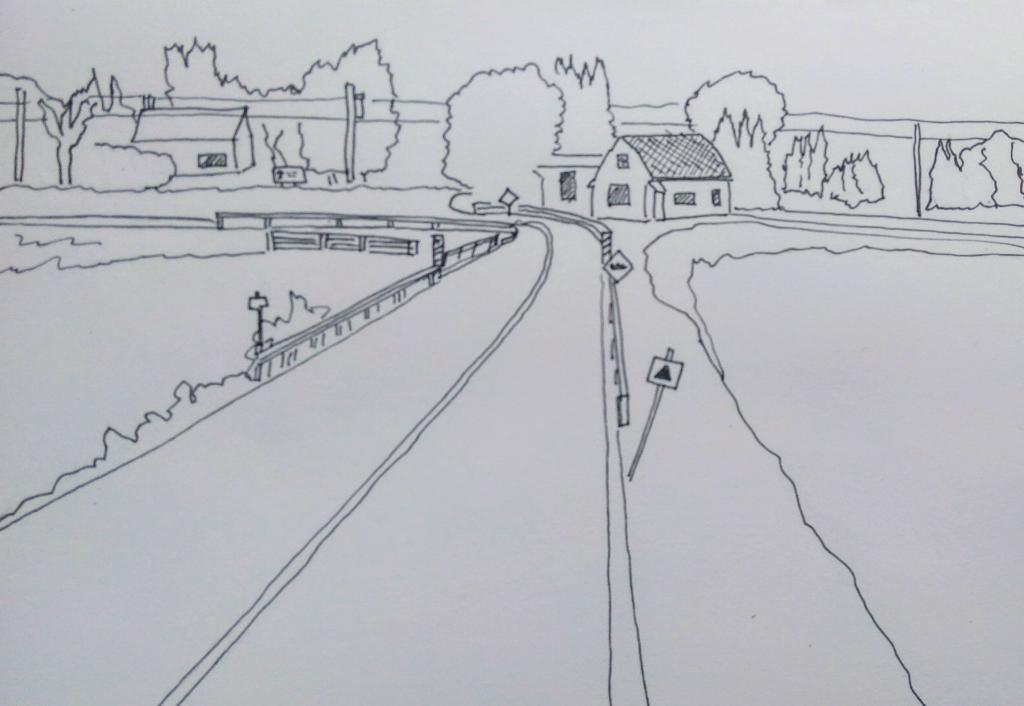 ,
,  ,
, 
From William Denton I followed a link to this recording of a Royal Academy talk by David Cannadine on Churchill and art.
In the introduction to the talk, Christopher Le Brun, President of the Royal Academy, mentions Lord Leighton:
And I immediately thought of my predecessor, Lord Leighton; that’s a slightly sad story, because he is the possessor of the shortest hereditary peerage in history: he was raised to the peerage on the 25th of January, I think 1896, and he died the very next day, so there’s not much material there, but there’s certainly plenty of material when it comes to Churchill.
Being a lapsed student, and a dilettante with regard to the arts, I’d never heard of Frederic Lord Leighton, but I was prompted to learn more.
Perhaps Le Brun was being sarcastic when he said “there’s not much material there,” as the more I learn about Lord Leighton, the more I am fascinated. While I will leave you to pursue your own curiosity in this regard, this catalogue from an exhibition of his works, held the year after he died, is a good place to start. My favourite part of the catalogue, what with me being me, is this note from the introduction:

You might also start with this 1996 article from The Independent that makes a compelling case for Lord Leighton having had an unrecognized son.
(And also, if some kind student of the British peerage would care to shed light, I’d love to understand more about what being “raised to the peerage” means, why Layton was a Lord in the first place, and why Leighton isn’t known as Baron Leighton today).
In the late 1980s Canasta scene in Peterborough, Ontario of which I was an active member, it was tradition to believe that it was required to say “partner, may I please go out,” when ready to do so. The definitive The Complete Canasta suggests a slightly less formal “Shall I go out?”, so I’m not sure from where we derived the wordier version, but it persevered.
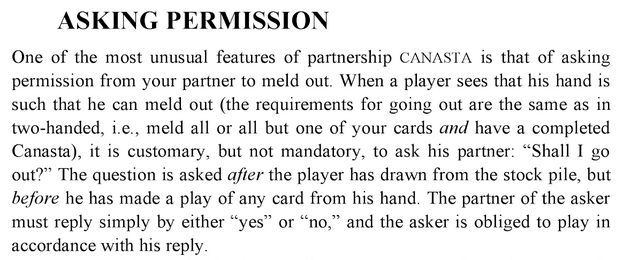
We certainly played more than our fair share of Canasta during the summer of 1987, and it remains the primary waypoint by which I mark that heady season.
I thought of “partner, may I please go out?” when I spotted this sign posted on the wall of the Queen Charlotte Armoury while attending its New Year’s Levee:
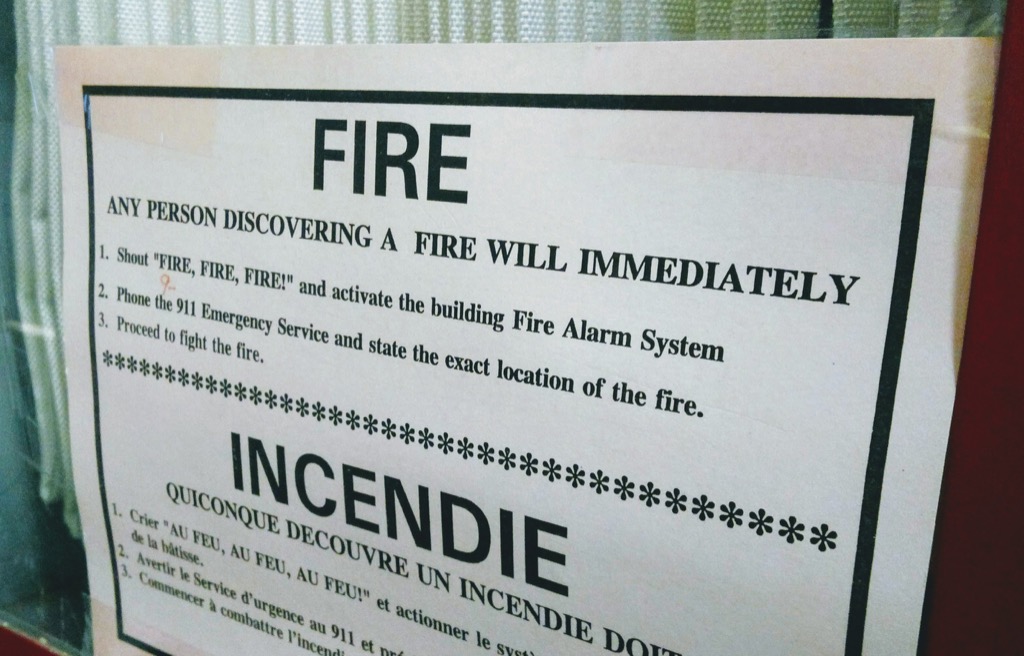
I appreciate the formality of the requirement to shout “FIRE, FIRE, FIRE!”, and also the seemingly strange suggestion–perhaps because this is a military installation where people have skills–that in step three one should “proceed to fight the fire” (standard civilian signage practice is, I believe, something more akin to “retire to a safe distance and allow professionals to put out the fire”).
 I am
I am